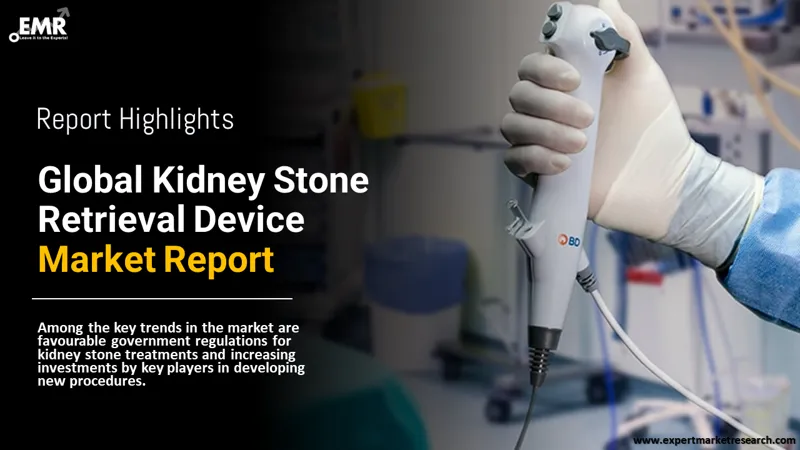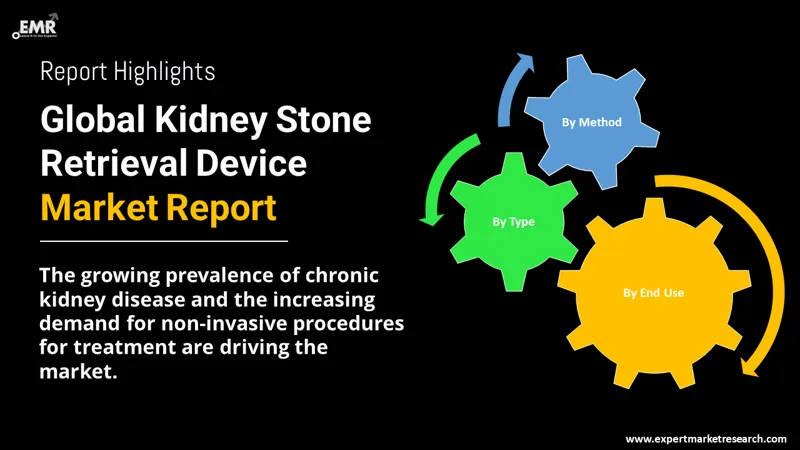
Consumer Insights
Uncover trends and behaviors shaping consumer choices today
Procurement Insights
Optimize your sourcing strategy with key market data
Industry Stats
Stay ahead with the latest trends and market analysis.
The kidney stone retrieval device market was valued at USD 3.07 Billion in 2025 and is expected to grow at a CAGR of 4.90%, reaching USD 4.95 Billion by 2035. The market growth is driven by rising incidence of kidney stones, advances in minimally invasive surgical techniques, and increasing demand for outpatient procedures.
Base Year
Historical Period
Forecast Period
The increasing prevalence of kidney stones and the growing aging population are expected to drive the market demand for innovative kidney stone retrieval devices.
The market share is positively impacted by the rising expansion of specialized urology and nephrology clinics, advancements in high-resolution imaging techniques, and increasing healthcare expenditure.
North America leads the market share due to the presence of key market players, such as Boston Scientific Corporation and Cook Group Incorporated, and high adoption rates of minimally invasive procedures.
Compound Annual Growth Rate
4.9%
Value in USD Billion
2026-2035
*this image is indicative*
Kidney stones are hard objects formed in the kidney due to accumulation of certain minerals in the urine. While some kidney stones stay in the kidney, some may start traveling down the ureter, which is the tube between the kidney and the bladder. This can cause extreme pain as it disrupts the flow of urine from the kidney to the bladder. Kidney stone retrieval devices are utilized for minimally invasive or non-invasive treatment options for kidney stones.

Read more about this report - REQUEST FREE SAMPLE COPY IN PDF
The kidney stone retrieval device market demand is propelled by the rising development of new and improved stone retrieval devices, such as advanced lithotripters and flexible ureteroscopes, that facilitate efficient stone removal procedures. The increasing prevalence of kidney stones and the growing aging population are significant growth drivers of the market that are fuelling the demand for innovative kidney stone retrieval devices and treatment options. Other factors that influence the market value include the expansion of healthcare infrastructure, rising adoption of advanced kidney stone retrieval technologies, and advancements in lithotripter technology.
Increasing Prevalence of Kidney Stones to Affect the Market Landscape Significantly
Recent data reveals that kidney stones affect around 1 out of 9 people and can lead to significant morbidity, severe pain as well as fatal kidney damage or infection. In the United States, it is estimated that about 10% of people will develop a kidney stone during their lifetime. The increasing cases of kidney stones are likely to propel the need for effective retrieval devices, such as ureteroscopes and lithotripters. Moreover, the high burden of kidney stone disease is poised to stimulate innovation and encourage research and development investment in the market.
Growth in Clinical Trials to Meet Rising Kidney Stone Retrieval Device Market Demand
In May 2024, California-based medical device company Calyxo Inc. announced positive clinical study results for its kidney stone removal technology, the steerable ureteroscopic renal evacuation (SURE) system, which demonstrated superior kidney stone clearance rates and lower residual stone volume compared to standard treatment (ureteroscopy). The SURE procedure was carried out using Calyxo's CVAC System, which is a stone clearance device that integrates ureteroscopy, laser lithotripsy, aspiration, and irrigation. The surge in clinical trials to evaluate new kidney stone removal technologies and ensure the safety and efficacy of various devices is anticipated to drive growth in the market.
The market is witnessing several trends and developments to improve the current global scenario. Some of the notable trends are as follows:

Read more about this report - REQUEST FREE SAMPLE COPY IN PDF
Kidney Stone Retrieval Device Market Report and Forecast 2026-2035 offers a detailed analysis of the market based on the following segments:
Market Breakup by Product Type
Market Breakup by Treatment
Market Breakup by End User
Market Breakup by Region
Market Segmentation Based on Treatment Type is Anticipated to Witness Substantial Growth
Based on the treatment type, the market includes extracorporeal shock wave lithotripsy (ESWL), intracorporeal ureteroscopy, and percutaneous nephrolithotripsy (PCNL). The ESWL segment holds a major market share and is widely utilized in hospitals and specialty clinics around the world. This treatment type is considered a standard treatment for kidney stones, especially for the ones present in the kidney and upper ureter. Since extracorporeal shock wave lithotripsy is a non-invasive procedure and has high success rates for stones of certain compositions and sizes, it experiencing high demand in the market. On the other hand, intracorporeal ureteroscopy is preferred for its minimally invasive nature and precision. Percutaneous nephrolithotripsy is used for removing large kidney stones through a minimally invasive surgical procedure.
Based on regions, the market report covers North America, Europe, Asia Pacific, Latin America, and the Middle East and Africa. North America dominates the market share owing to the high prevalence of kidney stones and the strong presence of key market players such as Boston Scientific Corporation and Cook Group Incorporated in the region. The market also benefits from the high healthcare expenditure and favorable reimbursement policies, which augments the market demand for advanced kidney stone retrieval devices.
Europe also holds a substantial market share due to the increasing aging population in the region. The rising demand for minimally invasive procedures and advanced diagnostic tools also influences the growth of the market in Europe.
The key features of the market report comprise patent analysis and strategic initiatives constituting recent partnerships and collaborations by the key players. The major companies in the market are as follows:
Cook Group Incorporated is a United States-based company engaged in manufacturing medical devices that facilitate minimally invasive treatment procedures. The key products of the company include a high-power holmium laser system, microcatheter, ureteral stent set, and drug-eluting peripheral stent, among others.
Richard Wolf GmbH is headquartered in Germany and was founded in 1947. It offers various stone retrieval instruments that enable efficient stone capture during endoscopic procedures. The company focuses on integrating advanced imaging and surgical technologies into its devices and significantly contributes to the kidney stone retrieval device market growth.
Boston Scientific Corporation is a leading company in endoscopy and developing minimally invasive devices for diagnosis and treatment. It is focused on helping healthcare providers to deliver services with increased efficiency and reduced cost. The company is known for its innovative lithotripsy systems and stone retrieval baskets.
Dornier MedTech GmbH, a leading manufacturer and distributor of urological equipment, has a prominent presence in the market. The company provides advanced kidney stone retrieval devices that complement its lithotripsy systems. Dornier MedTech also has a robust distribution network and invests heavily in continuous innovation of its products.
*Please note that this is only a partial list; the complete list of key players is available in the full report. Additionally, the list of key players can be customized to better suit your needs.*
Other key players in the market include Olympus Corporation and KARL STORZ SE & Co. KG.




*While we strive to always give you current and accurate information, the numbers depicted on the website are indicative and may differ from the actual numbers in the main report. At Expert Market Research, we aim to bring you the latest insights and trends in the market. Using our analyses and forecasts, stakeholders can understand the market dynamics, navigate challenges, and capitalize on opportunities to make data-driven strategic decisions.*
Get in touch with us for a customized solution tailored to your unique requirements and save upto 35%!
Explore our key highlights of the report and gain a concise overview of key findings, trends, and actionable insights that will empower your strategic decisions.
| REPORT FEATURES | DETAILS |
| Base Year | 2025 |
| Historical Period | 2019-2025 |
| Forecast Period | 2026-2035 |
| Scope of the Report |
Historical and Forecast Trends, Industry Drivers and Constraints, Historical and Forecast Market Analysis by Segment:
|
| Breakup by Product Type |
|
| Breakup by Treatment |
|
| Breakup by End User |
|
| Breakup by Region |
|
| Market Dynamics |
|
| Supplier Landscape |
|
| Companies Covered |
|
Datasheet
One User
USD 3,299
USD 2,969
tax inclusive*
Single User License
One User
USD 5,499
USD 4,949
tax inclusive*
Five User License
Five User
USD 6,999
USD 5,949
tax inclusive*
Corporate License
Unlimited Users
USD 8,199
USD 6,969
tax inclusive*
*Please note that the prices mentioned below are starting prices for each bundle type. Kindly contact our team for further details.*
Flash Bundle
Small Business Bundle
Growth Bundle
Enterprise Bundle
*Please note that the prices mentioned below are starting prices for each bundle type. Kindly contact our team for further details.*
Flash Bundle
Number of Reports: 3
20%
tax inclusive*
Small Business Bundle
Number of Reports: 5
25%
tax inclusive*
Growth Bundle
Number of Reports: 8
30%
tax inclusive*
Enterprise Bundle
Number of Reports: 10
35%
tax inclusive*
How To Order

Select License Type
Choose the right license for your needs and access rights.

Click on ‘Buy Now’
Add the report to your cart with one click and proceed to register.

Select Mode of Payment
Choose a payment option for a secure checkout. You will be redirected accordingly.
Gain insights to stay ahead and seize opportunities.

Get insights & trends for a competitive edge.

Track prices with detailed trend reports.

Analyse trade data for supply chain insights.

Leverage cost reports for smart savings

Enhance supply chain with partnerships.

Connect For More Information
Our expert team of analysts will offer full support and resolve any queries regarding the report, before and after the purchase.
Our expert team of analysts will offer full support and resolve any queries regarding the report, before and after the purchase.
We employ meticulous research methods, blending advanced analytics and expert insights to deliver accurate, actionable industry intelligence, staying ahead of competitors.
Our skilled analysts offer unparalleled competitive advantage with detailed insights on current and emerging markets, ensuring your strategic edge.
We offer an in-depth yet simplified presentation of industry insights and analysis to meet your specific requirements effectively.
Share